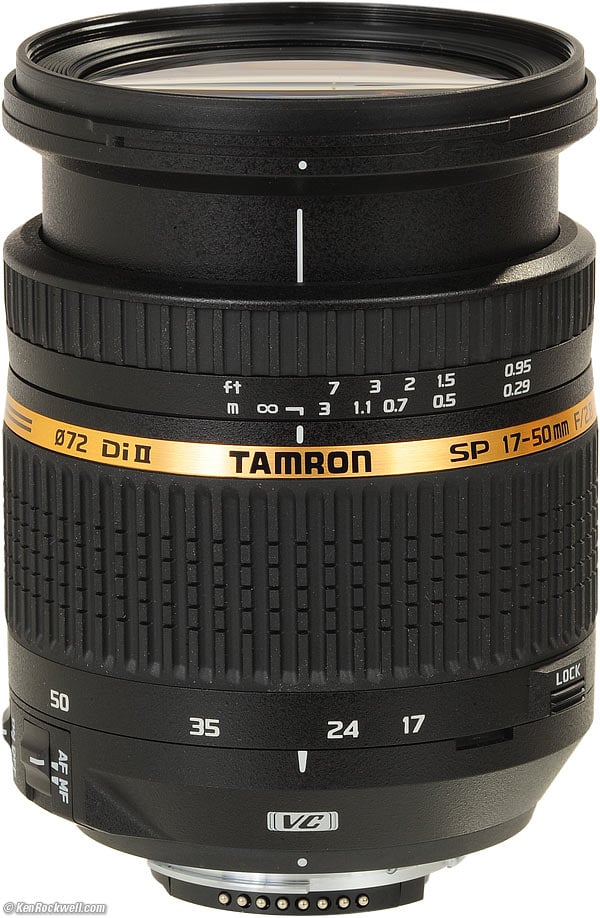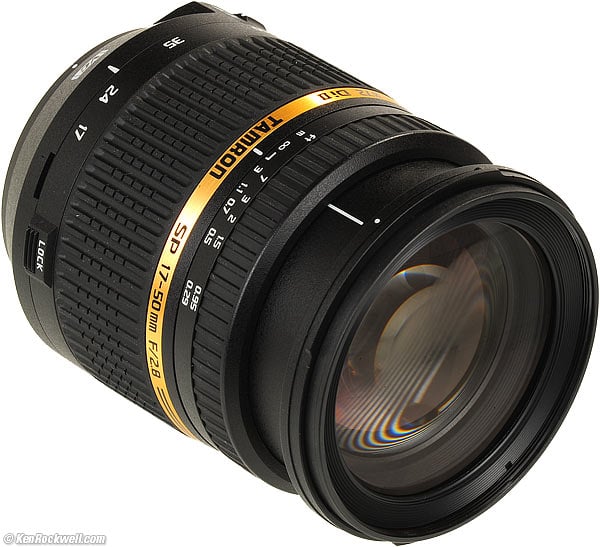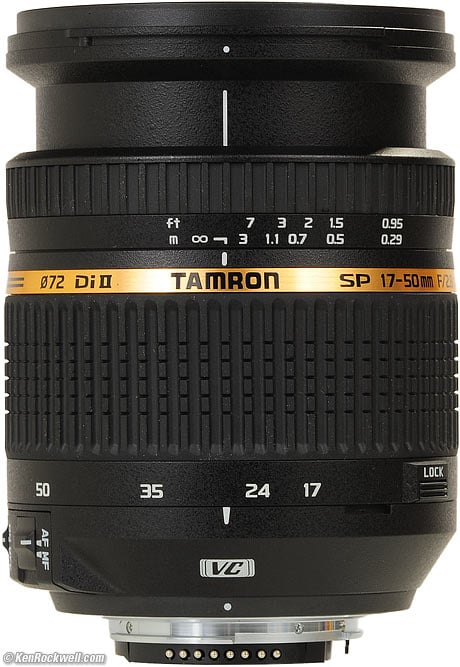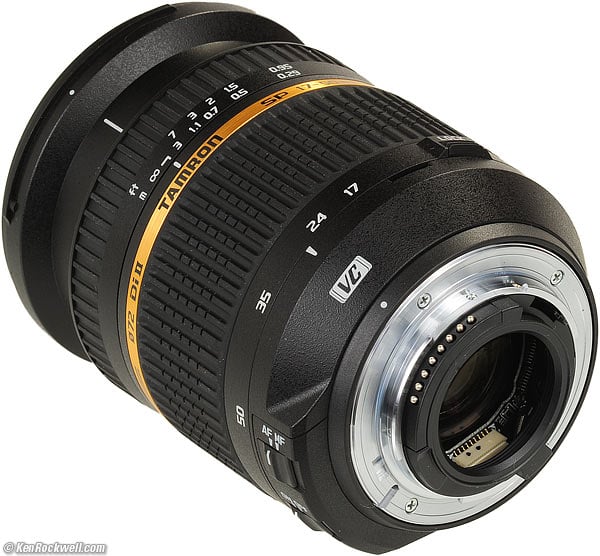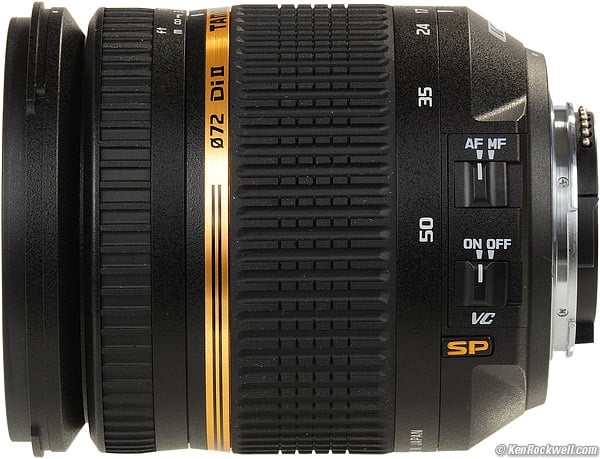Home Donate New Search Gallery Reviews How-To Books Links Workshops About Contact
Tamron 17-50mm f/2.8 VC
XR Di II LD Aspherical IF (2009-)
© 2011 KenRockwell.com. All rights reserved.
Intro Specifications Performance Usage Compared Recommendations
Tamron 17-50mm f/2.8 in Nikon mount (72mm filters, 20.1 oz. /569g, about $600), also comes in Canon mount. enlarge. This free website's biggest source of support is when you use these links, especially these directly to it at Adorama for Nikon, Adorama for Canon, at Amazon for Nikon, or at Amazon for Canon when you get anything, regardless of the country in which you live. Thank you! Ken.
February 2011 Tamron Reviews Nikon Canon All Reviews
Ideal Uses: Perfect for use on amateur digital (Nikon DX and Canon 1.6x) cameras as a general-purpose medium zoom. Unlike many non-Nikon lenses like Tokina and other Tamrons, this particular Tamron should works great on Nikon's cheapest D40, D40x, D60, D3000, D3100 and D5000.
Not for: 35mm, full-frame or FX cameras. Not for grab-shots with VC turned on.
| Optics: | |
| Mechanics: | |
| Ergonomics: | |
| Usefulness: | |
| Availability: | |
| Overall: |
Introduction top
Intro Specifications Performance Usage Compared Recommendations
|
I personally buy from Adorama, Amazon, Ritz, B&H, Calumet and J&R. I can't vouch for ads below.
|
This $600 Tamron has surprisingly good optics, but problems with its VC (VR or IS) and AF systems get in the way of good pictures.
I prefer my $200 Nikon 35mm f/1.8 DX, which is sharper, faster, smaller, lighter, focuses faster, easier and quieter, and is much less expensive. I'm not a fan of midrange zooms, but I must be the only one on earth who isn't.
If you're considering this mostly plastic lens, go for it. It works reasonably well — with one big catch:
This Tamron's VR/IS/VC system works only if you have the time to wait a moment before you snap each and every photo. There is a huge flaw if you make a photo before waiting a second for it to settle down. If you snap a photo without waiting for the VC/VR/IS system to settle, it will blur your image worse than if you had no VC, VR or IS! This is because this Tamron's VC system jumps as it locks and unlocks, so if you don't wait a moment with your finger half on the shutter for it to settle, it will blur your photo in the process of settling! Nikon's VR and Canon's IS systems don't have this problem. This blurred a lot of shots for me before I figured this out. Therefore, this is a horrible lens for news, sport, action and people shots unless you turn off the VR/IS/VC system. If you don't, and if you shoot at a moment's notice, the VC system will blur many of your shots!
This Tamron's other drawback is its primitive (noisy) internal autofocus motor, and that it uses a primitive AF system that requires you move a switch to get from auto to manual focus. You can't just grab the focus ring at any time, as you can do with the professional Nikon 17-55mm f/2.8 DX and Canon's 17-55mm f/2.8 IS.
Warning: this lens is made completely without permission from Nikon or Canon. While it probably will work with your camera, there's no telling that there won't be some weird incompatibility, and there is always the possibility of incompatibility with future cameras you might buy two years from today. Canon and Nikon lenses don't have this potential for problems.
When I say "ought to" below, I mean just that. All because this lens ought to work, doesn't mean that it will. I've only tried it on a Nikon D7000, on which it works swell.
Nikon
Everything should work perfectly on every DX digital Nikon, even on Nikon's cheapest digitals like the D40, D40x, D60, D3000, D3100 and D5000.
See Nikon Lens Compatibility for details with your camera. Read down the "AF-S, AF-I," "G" and "VR" columns for this lens. You'll get the least of all the features displayed in all columns, since "G" (gelding) is a deliberate handicap which removes features.
Canon
Everything ought to work swell with every Canon EOS 1.6x digital camera. that works with EF-S lenses. This lens seems as if it ought to work with very old 1.6x cameras that aren't EF-S compatible, but I didn't try any myself.
Tamron 17-50mm. enlarge.
Specifications top
Intro Specifications Performance Usage Compared Recommendations
Name
Tamron calls this the Tamron 17-50mm f/2.8 XR Di II VC LD Aspherical (IF).
This marketing baloney means:
XR: Extra Refractive-Index glass (allows smaller size)
Di II: Only works on 1.6x and DX cameras, won't work on 1.3x or 35mm or full-frame cameras.
VC: Vibration Control, same as Nikon VR or Canon IS.
LD: Same as Nikon's ED or Canon's UD glass. Probably all comes from Hoya.
Aspherical: Specially curved lens elements.
IF: Internal focusing. Nothing moves, except the focus ring, as focused.
Optics
19 elements and 14 groups!
Internal focusing.
BBAR "Broad-Band Anti-Reflective" multicoating.
Diaphragm
7 conventional blades
Stops down to f/32
Aperture Ring
None.
Coverage
Small-format digital, 16 x 24mm maximum.
Will not cover full-frame or 35mm film.
Focal Length
17-50mm.
On a DX camera gives angles of view similar to what a 26-75mm lens gives when used on an FX or 35mm camera.
Used on a Canon 1.6x camera, it covers angles of view similar to what a 27-80mm lens would see on a 35mm camera.
Angle of view
78°45' ~ 31°11.'
Close Focus
0.29m (11.4 inches) from the image sensor, which means just inches (centimeters) from the front of the lens.
Maximum Reproduction Ratio
1:4.8.
Hard Infinity Focus Stop?
No, you must let the AF system find infinity.
Focus Scale
Yes.
Depth-of-Field Scale
No.
Infra-Red Focus Index
No way, José.
Filter Thread
72mm, plastic.
Does not rotate, but pumps in and out with zooming.
Size
94.5mm (3.7 in) long by 3.13" (79.6mm) diameter, specified.
Weight
20.070 oz. (569.1g.), measured, in Nikon mount.
Tamron specifies 570g (20.1 oz.).
Hood
AB003 plastic bayonet, included.
Made in
Japan.
Warranty, USA
6 years.
Announced
Nikon Mount: 17 September 2009.
Canon Mount: 23 October 2009.
Tamron Model Number
B005.
Nikon: B005NII.
Canon: B005C.
Packaging
Silver-ink single-wall box, folded corrugated insert.
Included
Lens, paperwork, hood, caps.
No case.
Price
$600, USA, February 2011.
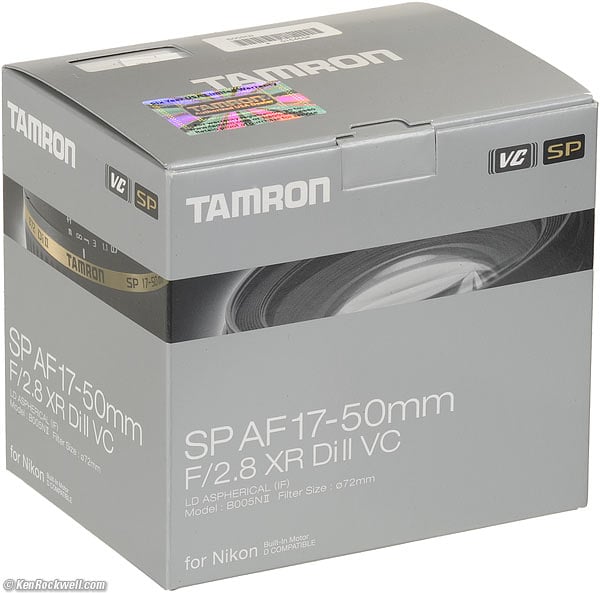
Box, Tamron 17-50mm.
Performance top
Intro Specifications Performance Usage Compared Recommendations
Overall Focus Bokeh Caps Cleanliness Distortion Ergonomics
Falloff Filters Focus Breathing Ghosts Lateral Color Fringes
Mechanics Sharpness Sunstars Vibration Control Zooming
Overall performance top
The Tamron 17-50mm works fine, but only it you remember to let the VC system stabilize before shooting. This is not a lens for grab shots with the VC system.
Autofocus performance top
AF Noise
This Tamron, at least in Nikon mount, uses a dinky electric motor to move the focus ring. It sounds like a toy.
This is how Canon did it — back in 1987.
AF Speed
AF speed is fast enough in Nikon mount.
The focus ring moves during autofocus, so keep your fingers off the focus ring during autofocus!
AF Accuracy
AF seems fine at f/2.8 at all focal lengths on my Nikon D7000.
Manual Focus
Manual focus is great; but you do have to move a switch.
Unlike the Nikon and Canon, you may not touch the focus ring until after you've moved the switch on the lens to MF. If you move the ring while in AF, you'll be working against the motor built into the lens.
What Moves
Focus is internal, so nothing moves externally except the focus ring, which moves even during autofocus.
Bokeh performance top
Bokeh, the character of out of focus backgrounds, not simply how far out of focus they are, is crummy at 50mm. At 50mm, backgrounds are bothersome at all apertures.
I didn't try at shorter settings; at shorter settings, depth-of-field is much larger so backgrounds are rarely out of focus to worry about bokeh.
Here are crops from the center of 100% DX 16MP (Nikon D7000) images, focused on a reference phase lattice (the black sides) at 3 meters (10 feet) with synthetic reference vegetation at 15 meters (50 fee). Printed full-image at this size, these would be about 50 x 33" (130 x 85 cm) prints, at least as seen on most 100 DPI computer monitors:
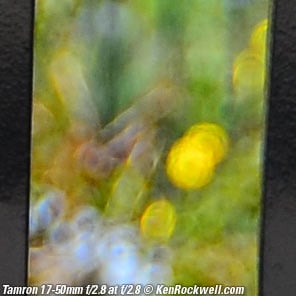 |
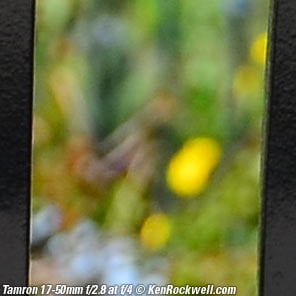 |
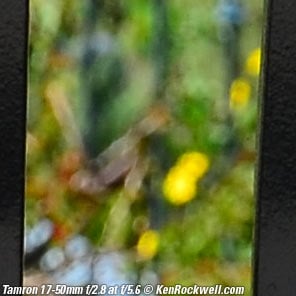 |
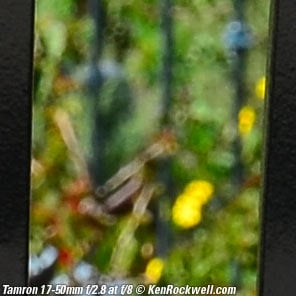 |
Caps performance top
The Tamron front cap is merely OK, although I'd leave it in the box and replace it with a good Nikon cap since the newest Nikon caps are much sturdier and easier to get on and off than the Tamron caps.
The Tamron rear caps for Nikon stink because you must stop what you're doing and align them carefully to the dot on the lens before you twist them on. Forget it!
I'd use a real Nikon rear cap instead, since you can pop them on without having to stop and look.
Cleanliness performance top
This Tamron arrived sealed from the factory with more than the usual amount of white dirt specks on the exterior.
You'd never notice this, but in my laboratory's clean-room where I open these and photograph them, I do.
Since I had to spend time spotting this out, I mention it here, because I hate wasting my time spotting-out dirt shipped by the manufacturer.
Distortion performance top
The Tamron 17-50mm has less distortion than expected.
It has barrel distortion at 17mm, and not much anywhere else.
This can be corrected for critical use by plugging these figures into Photoshop's lens distortion filter. These aren't facts or specifications, they are the results of my research that requires hours of photography and calculations on the resulting data.
| On Nikon DX at 10' (3m) |
Visible Effects |
|
17mm |
Barrel (bulging)* |
+3.5 |
24mm |
none |
+0.2 |
35mm |
none |
-0.5 |
50mm |
minor pincushion |
-1.0 |
© 2011 KenRockwell.com. All rights reserved.
* Some waviness remains even after correction.
Ergonomics (handling and ease-of-use) performance top
Tamron 17-50mm. enlarge.
Ergonomics are stinky:
1.) If you don't wait a moment for the VC system to stabilize, it will blur your photo!
2.) A switch stands between you and manual focus. Nikon and Canon's similar lenses don't need this switch; on them, just grab the ring.
3.) The focus ring moves during autofocus, so if you touch it, bad things happen.
Otherwise, it works swell.
Falloff (darkened corners) performance top
Falloff on Nikon DX is negligible. I never saw it, except in these deliberate torture-tests shooting gray fields and dropping them on top of a flat gray background.
The Canon sensor is slightly smaller, so it will be even less of a problem in Canon.
Tamron 17-50mm f/2.8 VC falloff at infinity on Nikon DX, no correction:
© 2011 KenRockwell.com. All rights reserved.
|
Filters, Use with performance top
Even thick (7.7mm thick, excluding rear threads) filters work great on Nikon DX. Canon has a smaller sensor, so vignetting will be even less of a problem.
Go ahead and use thick rotating polarizers. There's no need for expensive thin-mount filters with this Tamron.
Focus Breathing performance top
Of interest to cinematographers pulling focus between two subjects, the image from this Tamron 17-50 gets slightly smaller as focused more closely.
Ghosts performance top
Shot into the sun, there often can be two colorful green and blue blobs opposite the sun.
Lateral Color Fringes performance top
There are no lateral color fringes visible on the Nikon D7000, which corrects them automatically if they are there.
I can't speak for Canon, whose cameras aren't able to correct this as can all Nikon digital SLRs today.
Mechanics performance top
Tamron 17-50mm. enlarge.
The Tamron 17-50mm is all plastic, except for the lens mount and maybe (or maybe not) some internals. It's pretty good plastic, but still only plastic. I wouldn't kick it out of my camera bag based on how it's put together.
Barrel Exterior
Plastic.
Filter Threads
Plastic.
Hood
Plastic bayonet.
Focus Ring
Plastic; rubber covered.
Zoom Ring
Plastic; rubber covered.
Depth-of-Field Scale
None.
Aperture Ring
None.
Markings
Paint.
Identity Plate
Metal ring around barrel between focus and zoom rings.
Serial Number
Printed on a sticker glues onto the bottom of the zoom ring.
Ass-Gasket (rain seal at mount)
No.
Noises When Shaken
The usual clattering.
Warranty
Six Years, USA.
Made in
Japan.
Sharpness performance top
Warning 1: Image sharpness depends more on you than your lens.
Warning 2: Lens sharpness doesn't mean much to good photographers.
With those caveats, this Tamron 17-50mm is pretty good.
As seen on an 16MP DX Nikon D7000 at infinity:
At 17mm:
f/2.8: Sharp in the center, a bit blurrier in the corners.
f/4: About the same as f/2.8.
f/5.6: Better in the corners.
At f/8: Sharp everywhere.
At 24mm:
f/2.8: Sharp in the center, a little softer in the corners.
f/4: A little better than f/2.8 in the corners.
f/5.6: About the same as f/4.
At f/8: Sharp everywhere.
At 35mm:
f/2.8: A bit hazy everywhere from spherical aberration.
f/4: Much better than f/2.8. Sharp in the center, and almost as good in the corners.
f/5.6: A little better in the corners.
At f/8: Sharp almost everywhere, although the farthest corners are just a tiny bit softer than the center.
At 50mm:
f/2.8: A bit hazy everywhere from spherical aberration.
f/4: Much better than f/2.8. Sharp in the center, but softer in the corners.
f/5.6: About the same as f/4.
At f/8: Sharp almost everywhere, although the farthest corners are just a tiny bit softer than the center.
Sunstars performance top
With its straight 7-bladed diaphragm, the Tamron 17-50mm ought to make magnificent 14 -pointed sunstars on bright points of light.
Vibration Control performance top
The first thing you notice about this Tamron's Vibration Control (VC) is that the viewfinder image jumps left or right a few moments after you half-press the shutter and the VC stabilizes.
A few seconds after you take the picture, or let off the shutter, it jumps again as the VC system turns-off and locks-down.
There is a huge problem with this: the VC system usually does this right as I wanted to take a picture. I often got blurry images caused by this unless I deliberately waited for the VC system to stabilize before taking a picture.
This is not a problem if you remember to wait and your subjects hold still, but for general use and especially grab shots, this often leads to smeared photos.
Nikon's VR and Canon's IS systems don't have this problem because they don't jump around as they wake-up. The worst thing that happens with a Nikon or Canon lens is that you won't get IS or VR if you take the picture too quickly, but they'll never make it worse as will this Tamron.
When I say blurry, I mean blurry photos even in daylight at 1/250 of a second!
Beware.
Zooming performance top
Zooming feels great. It's easy to set any desired precise framing.
The zoom ring has the usual amount of drag. It makes a slight whining sound, implying maybe the use of metal zoom cams, but I somehow doubt it.
It has a zoom lock at 17mm, but the new sample I borrowed has no zoom creep to warrant using the lock.
Usage top
Intro Specifications Performance Usage Compared Recommendations
Tamron 17-50mm. enlarge.
As mentioned above, and as I need to reiterate here, with VC ON, you can't just shoot. You must wait a moment and let the VC system settle, which you'll see by the viewfinder image shaking, then stopping.
If you need to shoot fast in daylight, turn it off so you can shoot without waiting. Nikon and Canon don't have this problem; they don't shake the image as they turn on and off.
One always needs to move the AF switch to MF for manual focus. You may not touch the focus ring while in the AF mode, even when the camera is off.
Compared top
Intro Specifications Performance Usage Compared Recommendations
This Tamron has nothing in common with Nikon's 17-55mm f/2.8 DX or Canon's 17-55mm f/2.8 IS except for the f/stop and focal length range.
Both the Nikon and Canon lenses have silent focus, superior IS and VR systems, and allow instant manual-focus override at any time simply by grabbing the focus ring — no switches required.
Tamron 17-50/2.8 VC |
|||
| Filter Size | 72mm |
77mm |
77mm |
| VC/IS/VR | Yes |
no |
Yes |
| Will IS system blur photos if not allowed to settle? | Yes |
no |
no |
| Manual focus override | move switch |
just grab ring |
just grab ring |
| OK to touch focus ring in AF mode? | No! |
yes |
yes |
| AF motor | noisy |
silent |
silent |
| Focus ring turns by itself during AF? | Yes |
no |
no |
| Weight | 20.1 oz. (569g) |
27 oz. (760 g) |
23.0 oz. (652 g) |
| Build Quality | plastic |
metal |
plastic |
| Length | 3.7" (94mm) |
4.4" (110mm) |
4.4" (111mm) |
| Price, 2/2011, USA |
Recommendations top
Intro Specifications Performance Usage Compared Recommendations
This Tamron 17-50mm has swell optics, but a couple of fatal usability problems with its VC and AF systems.
Is getting a plastic lens with these problems worth saving money over buying the genuine quality product from Nikon or Canon?
If you want one of these, and aren't bothered by the ergonomic flaws I've mentioned, this Tamron's optics are very good; get one.
Personally, I prefer my Nikon 35mm f/1.8 DX as mentioned at the top. To each their own.
Deployment
I'd leave a 72mm Hoya Super HMC UV on the lens at all times. I would leave the hood at home.
I'd pitch the crappy Tamron cap and get a new Nikon front cap. I'm serious: the newest Nikon caps are much sturdier and easier to get on and off than the Tamron caps. Keep the Tamron cap stored in the box for when you resell your lens. I'd also replace the rear cap with a real Nikon rear cap, since Tamron's rear caps are tougher to attach because they have to be carefully aligned.
More Information
Help me help you top
I support my growing family through this website, as crazy as it might seem.
The biggest help is when you use any of these links to Adorama, Amazon, eBay, Ritz, Calumet and J&R and when you get your goodies. It costs you nothing, and is this site's, and thus my family's, biggest source of support. eBay is always a gamble, but all the other places always have the best prices and service, which is why I've used them since before this website existed. I recommend them all personally.
If you find this page as helpful as a book you might have had to buy or a workshop you may have had to take, feel free to help me continue helping everyone.
If you've gotten your gear through one of my links or helped otherwise, you're family. It's great people like you who allow me to keep adding to this site full-time. Thanks!
If you haven't helped yet, please do, and consider helping me with a gift of $5.00.
As this page is copyrighted and formally registered, it is unlawful to make copies, especially in the form of printouts for personal use. If you wish to make a printout for personal use, you are granted one-time permission only if you PayPal me $5.00 per printout or part thereof. Thank you!
Thanks for reading!
Mr. & Mrs. Ken Rockwell, Ryan and Katie.
Home Donate New Search Gallery Reviews How-To Books Links Workshops About Contact

